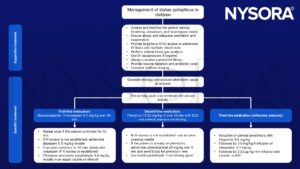Learning objectives
- Describe the overall mechanisms and etiology of status epilepticus in pediatric patients
- Manage status epilepticus in pediatric patients
Definition & mechanisms
- Status epilepticus is defined as more than 30 minutes of either 1) continuous seizure activity or 2) two or more sequential seizures without full recovery of consciousness between seizures
- Epilepsy is twice as common in children compared with adults
- Cerebral damage is more likely if the seizure is prolonged
- There are lots of different types of seizures and not all of them involve obvious convulsive activity
- Epilepsy can occur at any age but is commonly diagnosed in those aged below 20 or over 65 years
- First stage is characterized by an increase in:
- Cerebral metabolism
- Blood flow
- Glucose and lactate concentration
- Compensatory mechanisms:
- Massive catecholamine release
- Raised cardiac output
- Hypertension
- Increased central venous pressure
- After 30-60 min, compensatory mechanisms fail:
- Hypoxia
- Hypoglycemia
- Increased intracranial pressure
- Cerebral edema
- Hyponatremia
- Potassium imbalance
- Evolving metabolic acidosis
- Consumptive coagulopathy
- Rhabdomyolysis
- Multi-organ failure
Etiology
- Acute
- Stroke
- Metabolic abnormalities
- Hypoxia
- Systemic infection
- Anoxia
- Trauma
- Traumatic brain injury
- Drug overdose
- CNS infection
- CNS hemorrhage
- Chronic
Signs and symptoms
Status epilepticus can present in several forms:
- Convulsive: unresponsiveness and tonic, clonic, or tonic-clonic movements of the extremities
- Non-convulsive: prolonged seizure activity evidenced by epileptiform discharges on EEG, change in behavior or cognition in some patients
- Electrographic: commonly used for comatose patients who show electrographic evidence of prolonged seizure activity
Diagnosis
- Based on history and clinical examination
- Often present either actively convulsing or minimal time between clustered seizures
Prevention
- Seizure detection based on EEG and immediate treatment
- In patients with a history of well-controlled epilepsy, avoid disruption of antiepileptic medication perioperatively
Management

Suggested reading
- Glauser T, Shinnar S, Gloss D, et al. Evidence-Based Guideline: Treatment of Convulsive Status Epilepticus in Children and Adults: Report of the Guideline Committee of the American Epilepsy Society. Epilepsy Curr. 2016;16(1):48-61.
- Betjemann JP, Lowenstein DH. Status epilepticus in adults. Lancet Neurol. 2015;14(6):615-624.
- Perks A, Cheema S, Mohanraj R. Anaesthesia and epilepsy. BJA: British Journal of Anaesthesia. 2012;108(4):562-71.
- Barakat, A.R., Mallory, S., 2011. Anaesthesia and childhood epilepsy. Continuing Education in Anaesthesia Critical Care & Pain 11, 93–98.
We would love to hear from you. If you should detect any errors, email us at customerservice@nysora.com